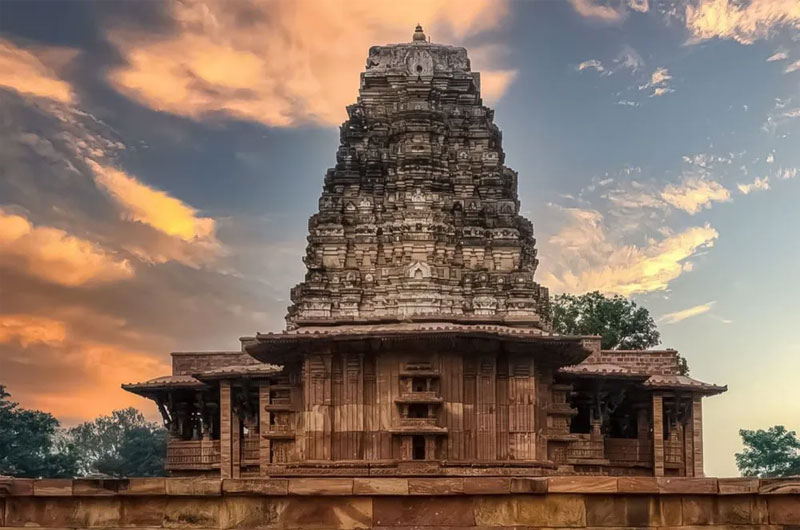
Rudreshwara Ramappa Temple: Epitome of Kakatiya Architecture – A World Heritage Site
Rudreshwara Ramappa Temple, popularly known as Ramappa Temple, is a remarkable example of Kakatiya architecture and craftsmanship. Located in Palampet village, near Warangal in Telangana, India, this temple is celebrated for its intricate carvings, exquisite sculptures, and unique architectural style. Inscribed as a UNESCO World Heritage Site in 2021, the Ramappa Temple stands as a testament to the artistic and engineering skills of the Kakatiya dynasty, particularly during the 12th and 13th centuries CE.
Historical Background
- Kakatiya Dynasty
- Flourished in the Deccan region of South India from the 12th to the 14th centuries CE.
- Known for their military prowess, administrative skills, and patronage of art and architecture.
- Temple Construction
- Built during the reign of Kakatiya ruler Ganapati Deva by his chief architect Ramappa.
- Completed around 1213 CE, dedicated to Lord Shiva (Rudreshwara).
Architectural Marvel
- Design and Structure
- Constructed using locally available red sandstone and black basalt.
- Known for its intricate carvings, including detailed friezes, pillars, and ceiling panels.
- Features a unique floating brick technique that allows the temple to withstand earthquakes.
- Notable Features
- Main Temple Complex: Consists of the sanctum sanctorum, antarala (vestibule), mahamandapa (great hall), and ardhamandapa (half hall).
- Temple Garbhagriha: Houses the main deity, Lord Shiva, with finely carved walls depicting mythological scenes and celestial beings.
- Nandi Mandapa: A pavilion with a large monolithic Nandi bull sculpture facing the sanctum.
Specialty of Rudreshwara Ramappa Temple
- Architectural Innovation
- Showcases the evolution of Kakatiya temple architecture with its unique structural and decorative elements.
- Represents a blend of Dravidian, Chalukyan, and Orissan architectural styles.
- Cultural Significance
- Served as a center of religious worship and royal patronage during the Kakatiya era.
- Reflects the region’s cultural synthesis and artistic achievements under the Kakatiya dynasty.
Tourism Aspects
- Visitor Experience
- Guided tours available to explore the temple complex and learn about its historical and architectural significance.
- Cultural programs and performances showcasing classical music and dance in the temple premises.
- Informative signage and audio guides for self-paced exploration.
- Nearby Attractions
- Warangal Fort: Historic fortification and palace complex dating back to the Kakatiya period.
- Thousand Pillar Temple: A marvel of Kakatiya architecture in Hanamkonda, known for its intricately carved pillars and monolithic Nandi.
- Kakatiya Musical Garden: A modern attraction near the temple, offering musical fountain shows and botanical gardens.
- Events and Festivals
- Ramappa Temple Festival: Annual cultural festival celebrating the temple’s heritage with rituals, music, and dance performances.
- Bathukamma Festival: Celebrated across Telangana, with vibrant floral decorations and cultural activities.
Impact on Locality
- Economic Significance
- Boosts tourism and local economy through visitor spending, hospitality services, and souvenir sales.
- Supports local artisans and craftsmen specializing in stone carving and traditional crafts.
- Cultural Influence
- Enhances regional pride and historical awareness.
- Promotes preservation of traditional arts, crafts, and cultural heritage.
Preservation and Challenges
- Conservation Efforts
- Managed by the Archaeological Survey of India (ASI) and local authorities.
- Ongoing restoration and maintenance to preserve the temple’s architectural integrity and historical authenticity.
- Challenges
- Preservation against natural weathering, pollution, and visitor impact.
- Balancing tourism with conservation needs to ensure sustainable development and cultural preservation.
Conclusion
Rudreshwara Ramappa Temple stands as a jewel of Kakatiya architecture and a testament to India’s rich cultural heritage. As a UNESCO World Heritage Site, it attracts visitors and scholars alike, offering a glimpse into the artistic achievements and engineering marvels of medieval India. The temple’s intricate carvings, innovative architecture, and cultural significance continue to inspire awe and appreciation for its historical legacy and spiritual essence for generations to come.
